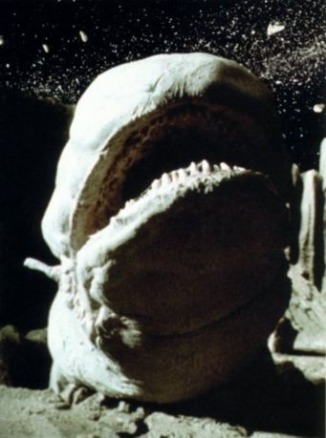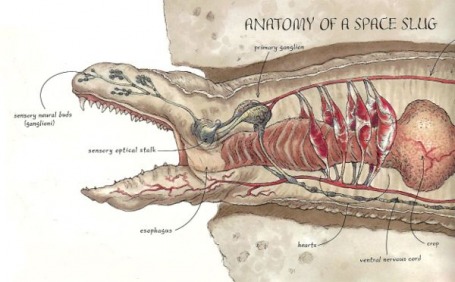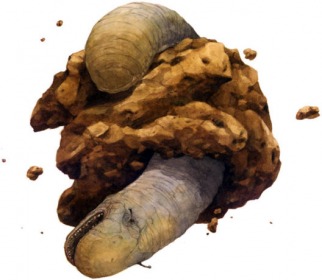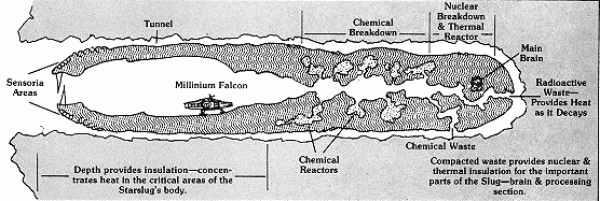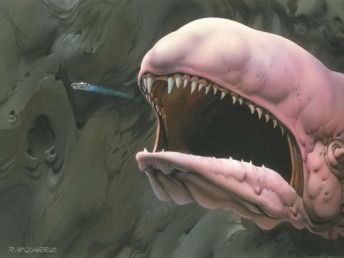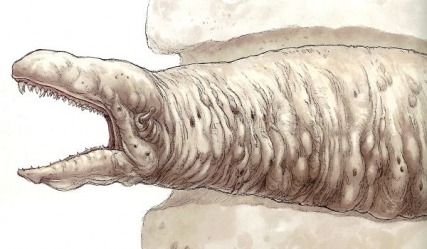The exogorth, known colloquially as the space slug, is a large species of toothed gastropod. They are silicon-based lifeforms that survive in the vacuum of space by making their homes in the caverns and craters of asteroids. They feed on the minerals of asteroids, various stellar energy fields, and mynocks (another silicon-based lifeform). The average adult space slug grew to about 33 feet in length, but some slugs have been known to continuously grow to sizes that rivale capital ships in sheer bulk, with some weighing over 150,000 tons.
Biology
Exogorths reproduce asexually by fission. Once an adult exogorth reaches a certain size, a chemical trigger will cause them to split apart into two identical exogorths. Whether through a genetic trait or by retaining the memory of their "parent", the two new exogorths will immediately become self-reliant.
An exogorth will travel through the asteroid fields they inhabite by pushing off the surface of one asteroid and floating through space to land on another. They also can use solar winds to help propel themselves through space. Through highly evolved sense of spatial awareness, the exogorth is capable of calculating the speed, trajectory, and distance of perilous moving bodies around them. This sense of spatial acuity also aids them in hunting food. They appear to be able to anchor themselves into a cave in an asteroid with tendrils, which also draw nutrition directly from the asteroid itself. As an exogorth does not remain in one asteroid for its entire life, it can be assumed that they could break free from their point of anchorage.
On occasion, the naturally occurring chemical trigger will cause the exogorths to kill whatever occurres near them. These oddities are known to reach sizes of nearly half of a mile in length. These colossal exogorths have been known to take sizable bites out of capital ships that passed too close to the slug's current dwelling, and even swallow smaller vessels whole. They have also been known to bite through a star destroyer's hull. At these sizes the mynocks they eat will often become internal parasites, rather than nourishment, living inside the cave-like esophagus of the exogorth that ate them. Some Exogorths have entire ecosystems of other life living within their digestive tracts.
A natural predator of the exogorth was the Colossus Wasp.
History
The House of Adasca found a way to control the exogorths after the Great Sith War. Based on the research of Gorman Vandrayk, Adascorp was able to control the hunger drives, growth rate, and reproductive fission processes of the Exogorths. Arkoh Adasca placed control mechanisms and hyperdrive engines on a group of exogorths and sought to sell them to the Republic, the Mandalorians, or the Revanchist faction as superweapons. With the Adascorp modifications, the exogorths could be sent through hyperspace to a specific system. Once there, their increased rate of growth and division could lead to destruction of space stations, asteroids, moons, and possibly even planets. The original exogorths could be sent to another system once they had divided, making it possible to disrupt or destroy hundreds of systems in a very short time. None of the parties who were invited to bid on these new weapons were enthusiastic about using them, however, all three were interested in making sure the weapon did not fall into the other parties' hands.
In one recorded occurrence an exogorth living in the asteroid field around the planet Hoth grew to a size of about 3000 feet in length. It was found and officially recorded by Gamgalon the Krish who made a living by capturing these massive specimens.
It is most likely this was the same space slug that Han Solo unwittingly hid the Millennium Falcon in when running from the Galactic Empire after the Battle of Hoth. Since exogorths insulate themselves deep inside asteroids and their own heat-generating waste Leia Organa, Han Solo, and Chewbacca were able to survive inside the space slug with only breath masks to provide oxygen. Solo had heard stories for years of the exogorths, and had been warned of their dangers, but he dismissed them as mere "ghost-stories". His run-in with that particular slug, however, changed his opinion.
Certain facilities that reside in space will often keep an exogorth living close by to help keep the pesky mynock population down. To keep these specially used slugs from reproducing and growing to uncontrollable sizes, katrium was introduced into the exogorth's system on a regular basis.
